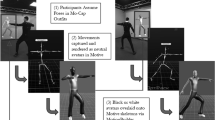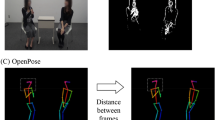Abstract
Past research has revealed that natural social interactions contain interactional synchrony. The present study describes new methods for measuring interactional synchrony in natural interactions and evaluates whether the behavioral synchronization involved in social interactions is similar to dynamical synchronization found generically in nature. Two methodologies, a rater-coding method and a computational video image method, were used to provide time series representations of the movements of the co-actors as they enacted a series of jokes (i.e., knock–knock jokes). Cross-spectral and relative phase analyses of these time series revealed that speakers’ and listeners’ movements contained rhythms that were not only correlated in time but also exhibited phase synchronization. These results suggest that computational advances in video and time series analysis have greatly enhanced our ability to measure interactional synchrony in natural interactions. Moreover, the dynamical synchronization in these natural interactions is commensurate with that found in more stereotyped tasks, suggesting that similar organizational processes constrain bodily activity in natural social interactions and, hence, have implications for the understanding of joint action generally.





Similar content being viewed by others
References
Bernieri, F. J. (1988). Coordinated movement and rapport in teacher-student interactions. Journal of Nonverbal Behavior, 12, 120–138.
Bernieri, F. J., Davis, J., Rosenthal, R., & Knee, C. (1994). Interactional synchrony and rapport: Measuring synchrony in displays devoid of sound and facial affect. Personality and Social Psychology Bulletin, 20, 303–311.
Bernieri, F. J., & Rosenthal, R. (1991). Interpersonal coordination: Behavior matching and interactional synchrony. In R. S. Feldman & B. Rime (Eds.), Fundamentals of nonverbal behavior. Studies in emotion & social interaction (pp. 401–432). New York: Cambridge University Press.
Cappella, J. N. (1981). Mutual influence in expressive behavior: Adult-adult and infant-adult dyadic interaction. Psychological Bulletin, 89, 101–132.
Chartrand, T. L., & Bargh, J. A. (1999). The chameleon effect: The perception-behavior link and social interaction. Journal of Personality and Social Psychology, 76, 893–910.
Cohen, J. (1988). Statistical power analysis for the behavioral sciences (2nd ed.). Hillsdale, NJ: Lawrence Earlbaum.
Condon, W. S., & Ogston, W. D. (1966). Sound film analysis of normal and pathological behavior patterns. Journal of Nervous and Mental Disease, 143, 338–347.
Condon, W. S., & Ogston, W. D. (1967). A segmentation of behavior. Journal of Psychiatric Research, 5, 221–235.
Davis, M. E. (Ed.). (1982). Interaction rhythms: Periodicity in communicative behavior. New York: Human Science Press.
Dittman, A. T., & Llewellyn, L. G. (1968). Relationship between vocalizations and head nods as listener responses. Journal of Personality and Social Psychology, 9, 79–84.
Eshkol, L. (1973). Moving, reading and writing. Holon: Movement Notation Society.
Feldman, R. (2007). Parent-infant synchrony: Biological foundations and developmental outcomes. Current Directions in Psychological Science, 16, 340–354.
Feldman, R., & Eidelman, A. I. (2007). Maternal postpartum behavior and the emergence of infant-mother and infant-father synchrony in preterm and full-term infants: The role of neonatal vagal tone. Developmental Psychobiology, 49, 290–302.
Garrod, S., & Pickering, M. J. (2004). Why is conversation so easy? Trends in Cognitive Sciences, 8, 8–11.
Gottman, J. M. (1981). Time-series analysis: A comprehensive introduction for social scientists. Cambridge: Cambridge University Press.
Haken, H., Kelso, J. A. S., & Bunz, H. (1985). A theoretical model of phase transitions in human hand movements. Biological Cybernetics, 51, 347–356.
Hove, M. J., & Risen, J. L. (2009). It’s all in the timing: Interpersonal synchrony increases affiliation. Social Cognition, 27, 949–961.
Huygens, C. (1673/1986). The pendulum clock or geometrical demonstrations concerning the motion of pendula as applied to clocks (trans. R. J. Blackwell). Ames: Iowa State University Press.
Isenhower, R. W., Marsh, K. L., Richardson, M. J., Helt, M., Schmidt, R. C., & Fein, D. (2012). Rhythmic bimanual coordination is impaired in children with autism spectrum disorder. Research in Autism Spectrum Disorders, 6, 25–31.
Issartel, J., Marin, L., & Cadopi, M. (2007). Unintended interpersonal co-ordination: “Can we march to the beat of our own drum?”. Neuroscience Letters, 411, 174–179.
Kelso, J. A. S. (1995). Dynamic patterns. Cambridge, MA: MIT Press.
Kendon, A. (1970). Movement coordination in social interaction: Some examples. Acta Psychologica, 32, 1–25.
Kimura, M., & Daibo, I. (2006). Interactional synchrony in conversations about emotional episodes: A measurement by “the between-participants pseudosynchrony experimental paradigm”. Journal of Nonverbal Behavior, 30, 115–126.
Kugler, P. N., Kelso, J. A. S., & Turvey, M. T. (1980). On the concept of coordinative structures as dissipative structures: I Theoretical lines of convergence. In G. E. Stelmach & J. Requin (Eds.), Tutorials in motor behavior (pp. 3–47). Amsterdam: North-Holland.
Kugler, P. N., & Turvey, M. T. (1987). Information, natural law, and the self-assembly of rhythmic movements. Hillsdale, NJ: Lawrence Erlbaum.
Kupper, Z., Ramseyer, F., Hoffmann, H., Kalbermatten, S., & Tschacher, W. (2010). Video-based quantification of body movement during social interaction indicates the severity of negative symptoms in patients with schizophrenia. Schizophrenia Research, 121, 90–100.
LaFrance, M. (1979). Nonverbal synchrony and rapport: Analysis by the cross-lag panel technique. Social Psychology Quarterly, 42, 66–70.
McDowall, J. J. (1978). Interactional synchrony: A reappraisal. Journal of Personality and Social Psychology, 36, 963–975.
McGarva, A. R., & Warner, R. M. (2003). Attraction and social coordination: Mutual entrainment of vocal activity rhythms. Journal of Psycholinguistic Research, 32, 335–354.
Miles, L. K., Griffiths, J. L., Richardson, M. J., & Macrae, N. C. (2010). Too late to coordinate: Target antipathy impedes behavioral synchrony. European Journal of Social Psychology, 40, 52–60.
Newman-Norlund, R. D., Noordzij, M. L., Meulenbroek, R. G. J., & Bekkering, H. (2007). Exploring the brain basis of joint action: Co-ordination of actions, goals and intentions. Social Neuroscience, 2, 48–65.
Newtson, D. (1993). The dynamics of action and interaction. In L. B. Smith & E. Thelen (Eds.), A dynamic systems approach to development: Applications (pp. 241–264). Cambridge, MA: The MIT Press.
Newtson, D., Engquist, G., & Bois, J. (1977). The objective basis of behavior units. Journal of Personality and Social Psychology, 35, 847–862.
Newtson, D., Hairfield, J., Bloomingdale, J., & Cutino, S. (1987). The structure of action and interaction. Social Cognition, 5, 191–237.
Oullier, O., De Guzman, G., Jantzen, K., Lagarde, J., & Kelso, J. (2008). Social coordination dynamics: Measuring human bonding. Social Neuroscience, 3(2), 178–192.
Passos, P., Araújo, D., Davids, K., Gouveia, L., Serpa, S., Milho, J., et al. (2009). Interpersonal pattern dynamics and adaptive behavior in multi-agent neurobiological systems: A conceptual model and data. Journal of Motor Behavior, 41, 445–459.
Pikovsky, A., Rosenblum, M., & Kurths, J. (2001). Synchronization: A universal concept in nonlinear sciences. New York: Cambridge University Press.
Ramseyer, F., & Tschachter, W. (2011). Nonverbal synchrony in psychotherapy: Coordinated body movement reflects relationship quality and outcome. Journal of Consulting and Clinical Psychology, 79, 284–295.
Richardson, M. J., Marsh, K. L., Isenhower, R., Goodman, J., & Schmidt, R. C. (2007). Rocking together: Dynamics of intentional and unintentional interpersonal coordination. Human Movement Science, 26, 867–891.
Richardson, M. J., Marsh, K. L., & Schmidt, R. C. (2005). Effects of visual and verbal interaction on unintentional interpersonal coordination. Journal of Experimental Psychology: Human Perception and Performance, 31, 62–79.
Rogers, S., Hepburn, S., Stackhouse, T., & Wehner, E. (2003). Imitation performance in toddlers with autism and those with other developmental disorders. Journal of Child Psychology, 44, 763–781.
Schmidt, R. C. (2010). Social motor coordination: Coordinated bodies, coordinated minds. Invited colloquium at the faculty of human movement sciences. Amsterdam: VU University.
Schmidt, R. C., Fitzpatrick, P., Caron, R., & Mergeche, J. (2011). Understanding social motor coordination. Human Movement Science, 30, 834–845.
Schmidt, R. C., & O’Brien, B. (1997). Evaluating the dynamics of unintended interpersonal coordination. Ecological Psychology, 9, 189–206.
Schmidt, R. C., & Richardson, M. J. (2008). Dynamics of interpersonal coordination. In A. Fuchs & V. Jirsa (Eds.), Coordination: Neural, behavioral and social dynamics (pp. 281–308). Heidelberg: Springer.
Schmidt, R. C., Shaw, B. K., & Turvey, M. T. (1993). Coupling dynamics in interlimb coordination. Journal of Experimental Psychology: Human Perception and Performance, 19, 397–415.
Sebanz, N., & Knoblich, G. (2009). Predictions in joint action: What, when, and where. Topics in Cognitive Science, 1, 353–367.
Shockley, K., Santana, M.-V., & Fowler, C. A. (2003). Mutual interpersonal postural constraints are involved in cooperative conversation. Journal of Experimental Psychology: Human Perception and Performance, 29, 326–332.
Strogatz, S. H. (1994). Nonlinear dynamic and chaos. Cambridge, MA: Perseus.
Strogatz, S. H. (2003). Sync: The emerging science of spontaneous order. New York: Hyperion Press.
Tickle-Degnen, L. (2006). Nonverbal behavior and its functions in the ecosystem of rapport. In V. Manusov & M. Patterson (Eds.), The SAGE handbook of nonverbal communication. Thousand Oaks, CA: Sage.
Trevarthen, C., & Daniel, S. (2005). Disorganized rhythm and synchrony: Early signs of autism and Rett syndrome. Brain & Development, 27, S25–S34.
Turvey, M. T., Rosenblum, L. D., Schmidt, R. C., & Kugler, P. N. (1986). Fluctuations and phase symmetry in coordinated rhythmic movement. Journal of Experimental Psychology: Human Perception and Performance, 12, 564–583.
van Ulzen, N. R., Lamoth, C. J. C., Daffertshofer, A., Semin, G. R., & Beek, P. J. (2008). Characteristics of instructed and uninstructed interpersonal coordination while walking side-by-side. Neuroscience Letters, 432, 88–93.
Varlet, M., Marin, L., Raffard, S., Schmidt, R. C., Capdevielle, D., Boulenger, J. P., et al. (2012). Impairments of social motor coordination in schizophrenia. PLoS One, 7, e29772.
Warner, R. M. (1998). Spectral analysis of time-series data. New York: Guilford Press.
Wilmermuth, S. S., & Heath, C. (2009). Synchrony and cooperation. Psychological Science, 20, 1–5.
Winfree, A. T. (1980). The geometry of biological time. New York: Springer.
Acknowledgments
This research was supported by National Science Foundation Awards BCS-0750187 and BCS-0750190 and Agence Nationale de la Recherche grant (Project SCAD # NT09_457350).
Author information
Authors and Affiliations
Corresponding author
Rights and permissions
About this article
Cite this article
Schmidt, R.C., Morr, S., Fitzpatrick, P. et al. Measuring the Dynamics of Interactional Synchrony. J Nonverbal Behav 36, 263–279 (2012). https://doi.org/10.1007/s10919-012-0138-5
Published:
Issue Date:
DOI: https://doi.org/10.1007/s10919-012-0138-5




